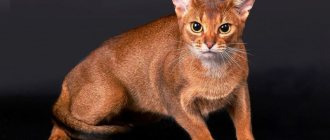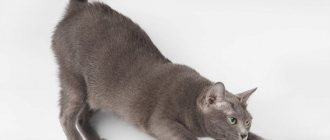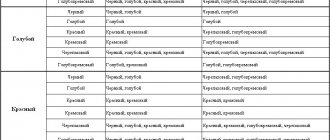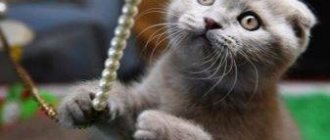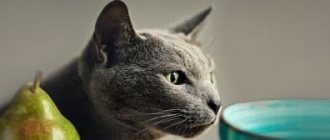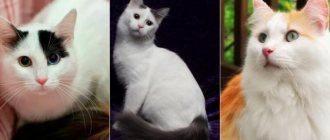Scottish cats are quite popular animals all over the world. But if you ask the average person about their color, the most common answer will be blue. These are the cats we most often see in films and commercials. But in fact, this breed has a lot of color variations. And today we will tell you about them.
Read the article about Scottish Folds on the Mister Cat portal.
Solid (solid, plain)
A solid color implies the absence of any slightest admixture of other shades. The surface of the fur is colored evenly on all parts of the body. The Scots once upon a time considered gray or blue to be the most common color. These are the favorites most often found among breeders. But today seals with other colors are also gaining more and more popularity: white, chocolate, black, brown, cream, red and fawn (which literally means the color of a young deer). Sometimes it happens that nature interferes with the uniform color of the fur and leaves a mark of a different color there. Such cats noticeably lose value because they are considered a breed defect.
Blue White Cream Black Cinnamon Chocolate Lilac Fawn Red
Color standards and disqualification
There are many color options. With a solid color there are no inclusions. The tone should be rich and even along the entire length of the hairs. If there are inclusions of a different color, then this is already considered a defect, which reduces the rating of a Scottish Fold blue kitten at exhibitions.
The most common solid color is blue. Until recently it was considered a classic. Today this is no longer the case. However, black, white, chocolate and red Scots are rarer animals.
Scotsman with blue color
The main disadvantages of Scottish Fold cats:
- tail stiffness
- ears that do not fit tightly to the skull
- profile with a stop
- stiffness in the spine
- skull deformation
- presence of age spots in the eyes
- undershot or undershot, missing teeth
- wrong number of fingers, crooked fingers
- visible or palpable break in the nose
Animals with dwarfism, umbilical hernia, blindness, strabismus, entropion, or white non-standard spots in the coat color are completely disqualified. Aggressive and alloyed cats are considered defective.
Point (point)
The more common name for this color is color point. It is characterized by the fact that the main color of the animal turns into a darker color at the tip of the muzzle, tail, ears and paws. This is due to the fact that in the blood of such animals there is a special gene that affects the darkening of the hair in those parts of the body where the temperature is low.
There are several variations of this color, which are shown in the table below, there may be others:
| Color name, photo | Main color | Additional color |
| Seal Point | Light beige | Brown |
| Lilac Point | White | Lilac |
| Blue Point | Pale blue | Dark blue |
| Chalklit Point | White | Brown |
| Cream-point Cream-blue-point | Pale cream | Cream |
| Red point | Pale cream | Ginger |
| Tabby (lynx) point | Any | Stripes to match the main color |
| Torty point | Tortoiseshell | Red or cream spots on the base coat color |
Torti (turtle)
It should be noted right away that you can only buy a turtle girl. In males, this color is not provided by genetics. But if you do come across a cat like this, then this is a big exception, which, however, does not increase its cost, but, on the contrary, reduces it.
Tortoiseshell color is considered to be fur on which spots of different colors (black, chocolate, blue, lilac) alternate with red or cream marks. For breeders, a particularly important indicator is the intensity of pigment expression and uniformity of location.
Blue + cream markings
Black + red markings Chocolate + red markings
Smoky (smoky, smoky)
The main condition for this color is that the hairs at the base of the body must have a silver-white tint. Those. the silvery-white hair turns into another color, such as black or blue. This phenomenon is called typing and occurs as a result of a dominant silver gene. The smoke can be different, for example, chocolate.
There are often cats with additional patterns on their fur, but according to color rules this should not be the case.
Smoky chocolate Smoky black Smoky blue
Don't confuse this color with a solid color! If you're not sure, part your cat's fur and see what color is at the base of his fur.
How to choose the right kitten
If you do not know the basic characteristics of the breed, you may encounter scammers. To be sure of the breed of Scottish Blue kittens, you need to buy from certified nurseries. Not everyone has the opportunity to buy a Scotsman because they are expensive.
How to choose a kitten?
Signs by which you should choose fold-eared blue kittens:
- Short plush fur
- They look like little bear cubs
- Big round eyes
- Ears folded into an envelope
- When viewed from the side, the mouth resembles a smile
- The nose is neat
- Availability of pedigree and documents with vaccinations
Tabby (tabby)
Such cats have stripes of an unusual shape and a different color than the main color. The most common marks are on the forehead, for example, in the shape of the letter M, light spots on the back of the ears, a necklace on the chest, rings on the paws and tail, curls on the cheeks, eyes outlined as if with shadows.
Breeders distinguish several variants of tabby. According to the type of pattern, they are marbled (shaded), tiger (mackerel) and spotted (spotted).
Brindle Spotted Marble
There is a complex classification of Scots tabby dogs based on combined colors and shades. They are presented in the table below:
| Name | Main color | Pattern color |
| Silver | Silver | Black |
| Silver blue | Light blue, white undercoat | Mantle on muzzle, tail and sides |
| Red | Light red | Bright red |
| Brown | Copper | Black |
| Blue | Cream blue | Bright blue |
| Cream | Pale cream | Beige or dark cream |
| Cameo | White | Bright red |
Characteristics of the Scottish breed
Scottish Folds have one obvious difference - folded ears. It is impossible to confuse these cats with anyone else. There are other distinguishing characteristics of the breed that you should know.
Standard
Scottish Folds resemble the British cat, as they are their closest relatives. But there are still differences. The description of the appearance of a representative of the Scottish Fold breed is as follows:
- Body: medium size, slightly elongated, with voluminous breasts. The limbs are round and of medium length, sometimes long.
- Head: rounded, blends smoothly into the neck. They have pronounced cheeks and a round chin.
- Eyes: round, widely spaced. Eye color depends on coat color; there are no specific standards.
- Ears: the main distinguishing feature of the breed. Small in size, widely spaced and curved forward. They have one, two or three folds. The more folds, the more they are pressed to the head and more closely follow its shape.
- Coat: Scots are typically short, plush, with a thick undercoat. There are also long-haired cats of this breed. They are called Highland Folds.
- Weight: on average from 3 to 8 kg.
- Color: any color is allowed according to the standards.
A little more about colors. The following types are distinguished:
- solid - a shade of one tone, any color: black, white, blue (cold gray), chocolate, lilac, red;
- tortoiseshell - spots of more than 2 different shades, harmoniously located throughout the body or throughout the entire coat except the chest and paws;
- smoky – plain outer coat with a silvery-white undercoat;
- chinchilla - the base of the hair color is white, and the eighth part is colored;
- tabby - color with brindle, striped, spotted or marbled patterns;
- bicolor - a combination of white with blue, black or red, preferably white on the legs, paws, stomach, chest, chin and part of the face;
- van – the main coat color is white, the tail and two spots on the head are of a different color;
- harlequin - the main part of the coat is white, and a fifth of it is of a different shade;
- colorpoint - the shade of the entire coat is light, and the paws, tail, ears and muzzle are of a contrasting color.
Reference! From birth, kittens' ears are straight; by the age of five weeks they acquire a permanent shape. It can be either curved or remain straight.
Health
The life expectancy of Scottish cats is on average 12-15 years. They are quite strong animals. They have good health until old age, with proper care and nutrition. But since the breed was created using genetic mutations, this left its mark on the health of the offspring. Folds have some hereditary diseases:
- The most common is osteochondrodysplasia . This is a genetic disease of the musculoskeletal system that causes impaired growth of cartilage and bones or their deformation.
- Entropion of the eyelid , which is removed with surgery.
- Possible development of cataracts and glaucoma .
- Ear infections.
- Partial or complete deafness.
- The risk of developing obesity due to unpretentiousness in food.
Important! It is imperative to vaccinate the animal, regardless of the conditions of detention. Cats that live exclusively in an apartment are also susceptible to infections that can be brought in by people.
Character
Scottish Folds are cats that are suitable for almost any family. Easily adapt to new surroundings. They are not intrusive, calm, soft and peaceful animals. Of all the family members, they choose one favorite, which they consider their master. In his absence, they will be bored, and when he appears at home, they will follow on his heels.
These cats do not show aggression or too much activity. Scottish Folds divide their day into approximately 2 equal parts: active with games and exploration of the apartment, and sleep. The Scots like to lie down in some interesting position, for example, lying on their backs and spreading their paws. Or stand in the meerkat pose on your hind legs.
The Scots get along well with children. They will be able to steadfastly endure the attacks of their little owners, but this does not give children the right to mock the pet. You can simply rest assured for your child if he accidentally grabs or strokes the cat more than usual. The Scots react absolutely calmly to dogs. The Scots also have special sounds. They do not purr like ordinary cats, but make something similar to a quiet squeak.
Representatives of this breed are trainable. It's easy to teach them to go to the litter box. Due to their flexibility, they can easily master simple tricks. With the right amount of patience, you can teach a Scot to use the toilet as his toilet.
Chinchilla
Cats of this appearance are quite rare, which is why their prices are much higher. With the chinchilla type of color, each hair is white and only 15% of it at the end is colored either golden-blue, gold, or silver. The Blue Golden Chinchilla is the rarest of the three.
Silver
Gold
Blue golden
The structure of a cat
Representatives of the cat family are distinguished by extraordinary elegance and grace, mobility and energy, which largely determines the structure of the animal.
Anatomical structure of the cat skeleton: 1 – facial part of the skull; 2 – lower jaw; 3 – brain part of the skull; 4 – first cervical vertebra; 5 – cervical vertebrae; 6 – shoulder blade; 7 – thoracic vertebrae; 8 – ribs; 9 – lumbar vertebrae; 10 – sacrum; 11 – pelvis; 12 – caudal vertebrae; 13 – femur; 14 – tibia and fibula; 15 – metatarsus; 16 – fingers (paw); 17 – metacarpus; 18 – radius and ulna; 19 – humerus; 20 – sternum
Skeleton
It is advisable to start describing the structural features of a cat with the skeleton. Its structure is in many ways reminiscent of the structure of the skeleton of all mammals, differing in the shape and arrangement of some bones.
This is explained by the horizontal position of the cat’s spine and the fact that the functioning of the animal’s organ systems is adapted to its lifestyle.
The cat's skull has a round shape. Moreover, it is significantly shorter than that of many other predatory animals.
The size of the adult skull varies depending on gender and individual hereditary characteristics.
The bones of the skull are much larger than the bones of the facial part of the skull. This feature makes the cat's appearance different from other animals.
A cat's spine is flexible and mobile. It consists of 27 vertebrae: 7 cervical, 13 thoracic and 7 lumbar. Below the lumbar region there are 3 fused vertebrae that form the sacrum. Next come the caudal vertebrae. On average, a cat's tail consists of 20–23 vertebrae.
Thanks to the elastic and movable tail, cats can maintain balance while jumping and in the event of a fall from a height.
Also, experienced breeders of these animals can easily determine what mood they are in by the position and movements of their pet’s tail.
Ticking
Looking at these cats, it seems that their fur shimmers so much that it is difficult to determine what color it is. Such animals are quite expensive. If we look at a single hair, we will see that its coloring is far from monotonous - stripes of different colors alternate across it, and the tip is always dark.
Black silver ticked
Golden ticked
Features of care
Scottish Fold cats can be either short-haired or long-haired. Therefore, the most important thing in care is to take care of your pet’s coat. It is necessary, using a furminator, to remove fallen hairs from the thick plush undercoat, and also with its help to remove the resulting tangles. Long-haired cat breeds are recommended to be brushed every week. It is not customary to trim Scottish Folds.
Scottish fold marbled cats are not afraid of water. They can wet their paws in the container themselves, but this does not mean that they need to be bathed often. Cats are quite clean and take care of their fur by licking it. If there is a need to bathe your pet, you need to use a special shampoo so as not to cause allergies. Many cats love to swim if they have lived since childhood where there is a pool or natural pond.
Since cats' ears are literally pressed to their heads, they need to be given special attention. The wax that has formed in the ear should be removed. For this procedure, cotton swabs and a special liquid are used, which is sold in veterinary stores.
Shedded (shaded)
With this type of color, two-thirds of the hair starting from the base is white, and the remaining part can be red, silver or gold. On the chin, belly and lower surface of the tail the color is light. The shaded color does not allow spots or stripes except those located on the forehead or paws.
Red shaded
Golden shaded
Silver shaded
Wang
Representatives of the Scottish breed with a similar color have white coat color as the main color, and the tail and muzzle are decorated with a different color or a combination of both (torti). There may also be spots on the body and paws.
Harlequin
This coat color is very similar to the Van. The same colored tail and muzzle, but the main difference between the harlequin is the presence of spots on the body. Outwardly, such cats really look like the hero of an Italian comedy.
The rarest colors of Scottish cats
Several years ago, the highest price was set for kittens of unusual silver and gold shades. But in the modern cat market there are more and more of them. Today, ticked Scots and golden chinchillas are considered the most expensive.
Scottish straight golden chinchilla
Interesting! The most common iris color among Scots is gold. However, there are some exceptions. Usually the eye color matches the coat. Blue or multi-colored eyes are quite rare, these animals can be white, bicolor or tortie. Orange iris is a very beautiful, but the rarest eye color in this breed.
Genetics of Scottish cat colors
In cats of this breed, 2 genes predominate, which are responsible for the red and black color. One of them acts as dominant, and the other as recessive (i.e., the one that is suppressed). There is also a 3 diluent gene, which is responsible for the saturation of the pigment. These genes are combined and as a result we get a variety of colors: from the well-known blue to the cheerful-looking harlequin.
By the way, while the kitten is still small (several weeks), it is impossible to say exactly what its color will be. The final coloring is formed when, after a child's molt, the coat is replaced by an adult coat. Usually the color is ready by six months, although it may change slightly for another 1.5 years.
The second stage is independence and growing up
| Age | Image | Peculiarities | Recommendations |
| Sixth week | The final transition from mother's milk to foreign food | Feed the kitten 6 times a day, 40 grams of food at each meal. Observe the animal's stool; if there are any problems, contact a veterinarian after 3 days. | |
| Seventh week | Weight – 550-900 g. Males stand out among females in size | The kitten should not drink its mother's milk. Balance of dry and liquid food | |
| Eighth week | Weight – 750 – 1200 g. All milk teeth. Eats solid food | Separate from mother. Get examined by a veterinarian. Monitor the condition of your ears and eyes. Comb | |
| Ninth week | Forming a type of relationship with the owners | Get vaccinated | |
| Tenth week | Weight – 850-1400 g. Independence. Sensitivity to learning | Do not be aggressive in training | |
| Eleventh week | Research stage: exploring the corners of the apartment | Prevent the kitten from colliding with dangerous objects: close windows, remove small parts, toxic substances | |
| Twelfth week | Weight – 900-1600 g. Change of eyes Pet’s response to its name, to the call for food | Organize repeated prophylaxis against worms. Stop kitten aggression | |
| Thirteenth - fifteenth weeks | Weight – 1.5 kg. Molars appear | Feed 5 times a day. Trim nails regularly | |
| Sixteenth week | Weight – 1.8 kg | Get vaccinated | |
| Five months | Weight – 2 kg | Feed 4 times a day. Get a rabies vaccination | |
| Six months | Strong molars. Dimensions of an adult animal. Puberty | Organize worm prevention. Feed 3 times a day. Sterilize if there is no goal to breed offspring | |
| Seven months | Seasonal molt | Brushing your pet | |
| Eight – nine months | The cat is almost an adult | Sterilize if not done before. Consult your doctor about vaccination | |
| Ten – eleven months | Adult phase of life | Include food for adult cats in the diet |
Cat vaccination periods
Important! When the cat turns one year old, his diet should consist only of food for adults, and meals should be reduced to 2 per day.
Scottish cat color charts
When purchasing a Scottish kitten with a passport from a breeder, most likely you will see markings of numbers and letters there. This is an international code used in the classification accepted among breeders. The Scottish breed includes four cats: fold-eared (Scottish Fold), straight-eared (Scottish Straight), long-haired fold-eared (Highland Fold), straight-eared long-haired (Highland Straight).
This is what the color code looks like: XXX.xx.NN.NN.NN.(NN) , where:
XXX . Abbreviated name of the breed in three capital letters: SFS - Scottish Fold, SFS 71* - Scottish Straight, SFL - Highland Fold, SFL 71* - Highland Straight.
xx . Lowercase letters indicating the main coat color (up to two):
| Letter (designation) | English name | Russian name |
| a | blue | blue |
| b | chocolate, brown, chestnut | chocolate, brown, Havana, champagne |
| c | lilac, lavender | lilac, lavender, platinum |
| d | red, flame | red |
| e | cream | cream |
| f | tortoiseshell, patch | tortoiseshell |
| g | blue-cream, blue-tortie | blue cream, blue tortoiseshell |
| h | chocolate-tortie | chocolate tortoiseshell |
| j | lilac-tortie | lilac tortoiseshell |
| n | black, ebony, seal, sable, ruddy | black, ebony, seal, sable, wild |
| o | sorrel, cinnamon, honey | sorrel, cinnamon, honey |
| p | beige fawn | yellow-brown, beige |
| q | sorrel tortie | red-brown tortoiseshell |
| r | beige fawn cake | beige tortoiseshell |
| s | silver, smoke | silver, smoky |
| w | white | white |
| y | golden | golden |
| z | unregistered | unregistered |
NN.NN.NN.(NN) - values of pairs of digits (up to 3 main and 1 auxiliary):
- Numbers from 1 to 35, which decipher the color features (harlequin, van, smoke, etc.):
| Letter (designation) | English name | Russian name |
| 01 | van | van |
| 02 | harlequin | harlequin |
| 03 | bicolour | two-color, bicolor |
| 04 | mitted/white point | with white markings (for color points) |
| 09 | little white spots | white spotting (1-2 cm) |
| 11 | shaded | shaded (1/4 of the top part of the hair is darkened) |
| 12 | tipped, shell | veiled (1/8 of the top part of the hair is darkened) |
| 21 | tabby, agouti | striping, agouti factor |
| 22 | blotched, marble | marble |
| 23 | mackerel, tiger | mackerel, tiger |
| 24 | spotted | spotted |
| 25 | ticked | ticked or Abyssinian |
| 31 | burmese | Burmese |
| 32 | tonkinese | Tonkinese |
| 33 | himalayan or siam | Himalayan, Siamese, point |
| 34 | Singapore | Singaporean |
| 35 | abyssinian | Abyssinian |
- A pair of numbers from 51 to 54 indicating the length of the tail:
| Letter (designation) | English name | Russian name |
| 51 | rumpy | taillessness |
| 52 | rumpy riser | remainder of the tail – 1-2 vertebrae |
| 53 | stumpy | bob – 7-13 cm. curled tail |
| 54 | longy | long/normal tail |
- A pair of numbers from 61 to 67 indicating eye color:
| Letter (designation) | English name | Russian name |
| 61 | blue | blue |
| 62 | yellow, golden | yellow, orange, golden |
| 63 | oddeyed | disagreement |
| 64 | green | green |
| 65 | burmese | Burmese cat eye color |
| 66 | onkinese | Tonkinese cat eye color |
| 67 | himalayan or siam | eye color of Himalayan and Siamese cats |
- A pair of numbers 71 (straight) or 73 (dropping), indicating the shape of the ears.
How coat color affects the character of a Scotsman
When purchasing a pet, you should not chase fashion; it is better to trust your preferences and tastes. The main thing is that the cat turns out to be “yours” in temperament and character. By the way, some cat owners are sure that the color of the fur affects the behavior of the animal and leaves an imprint on its character.
White and light colored
You want to cuddle these babies endlessly. But they, as a rule, do not like increased attention to themselves. Although they are very loyal to the owner, they are extremely wary and wary of other people. Among some peoples there is a belief that a white cat brings good luck. Whether this is true or not is not known for certain. But the white color can cause a lot of problems for the cats themselves, since 5% of all snow-white cats are born completely deaf. Previously, it was believed that deafness was the fate of absolutely all white-furred tails, but later scientists proved that this is not so. But when buying such a kitten, you should still be more careful.
Black
Despite all the existing prejudices and myths regarding black cats, in practice they are one of the friendliest towards people. They like to stay close to their owner all their free time and always keep him in sight. Charcoal cats are wise, quick-witted, and keenly aware of a person’s mood.
Redheads
Such animals are a ray of sunshine in your home. It is believed that a ginger cat in the home is the key to an indispensable increase in well-being. Those with fiery fur are very playful, willful, cheerful and curious creatures. The golden shades of fur that are fashionable today are characteristic of more formidable animals, whose disposition can hardly be called friendly. And golden Siamese cats are generally considered the worst tailed cats.
Blue and silver
Silver and blue fluffies are real aristocrats. Calm, balanced, noble. They love their owner devotedly, although they are not always ready to demonstrate this publicly. It is believed that these four-legged pets are able to calm and relieve stress in humans. In addition, cats of this color are absolutely not vindictive.
Two-color
Such cats are most in demand among buyers. In addition to their interesting color, they have an easy-going disposition, are friendly, and kind even towards children. Bicolor cats love their owners very much and get along well with other pets.
Tortoiseshells
We are talking specifically about cats, since among cats this color is not a sign of the breed, but, on the contrary, its defect. Pussy turtles are extremely friendly, intelligent, and even slightly flirtatious. They enjoy communicating with new people and love their owner. In some countries, having such a cat at home is a symbol of wealth and prosperity.
Prices
As a rule, breeders approach their business responsibly. However, before deciding to buy a kitten, you should study its physical characteristics. When choosing a Scottish Fold, you need to make sure that its paws are flexible and its tail is mobile. If they are hard, then the kitten may be predisposed to osteochondrodysplasia.
On average, the cost of a Scottish fold kitten in Russia from a professional breeder with documents is from 10,000 to 25,000 . If the kitten has titled parents, then the cost can double or triple.
A Scottish Fold kitten without a pedigree can be purchased for 5,000-8,000 rubles . If the cost of the baby is less than 5,000, then you should seriously think about buying. You may later discover serious health problems or defects in your pet's appearance.

